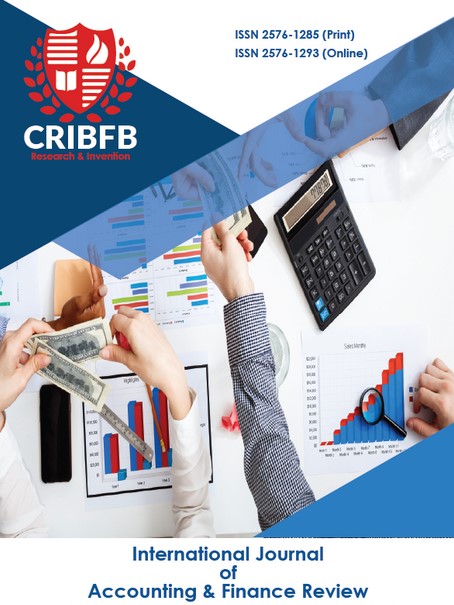THE ROLE OF INVESTOR SENTIMENT ON PRICING EFFECT OF PROFITABILITY RISK FACTOR IN KENYA
Main Article Content
Abstract
Emerging stock markets are characterized by strong investor sentiment and rapid fluctuations in returns. However, the role of investor sentiment on asset pricing has not been explored in these markets. This study sought to establish if the effect of the profitability risk factor on stock returns would vary with the level of investor sentiment at the Kenyan equity market. A quantitative causal time-series design was adopted to analyze the cause-effect relationship among the study variables. The study utilized monthly equity return data on 60 firms listed at the Nairobi Securities Exchange (NSE) from 2011 to 2019. Test portfolios were constructed following the Fama-French five-factor model framework. Auto-Regressive Distributed Lag (ARDL) and Vector Error Correction (VEC) estimation techniques show that profitability risk factor is a significant predictor of stock returns at a 5% level. Overall, though not consistent with valuation theory, the coefficient on profitability risk factor is negative, implying a high exposure to profitability risk results in low returns. Further, adding sentiment variables to the main effects model would enhance the significance of the profitability risk factor at the NSE. The evidence presented contributes to establishing investment strategies, estimating the required rate of return and assessing portfolio performance of collective investments.
JEL Classification Codes: C32, G11, G12, G14, G41.
Downloads
Article Details
Section
How to Cite
References
Ayrapetova, T & Larionova, K. (2016). The Cost of Equity in Emerging Markets: A Downside Risk Approach. Retrieved from https://Faculty.Fuqua.Duke.Edu/~Charvey/Teaching/Ba456_2001/Estrada.Pdf
Baker, M., & Wurgler, J. (2006). Investor sentiment and the cross‐section of stock returns. The journal of Finance, 61(4), 1645-1680. Retrieved from https://afajof.org/journal-of-finance.
Baker, M., & Stein, J. C. (2004). Market liquidity as a sentiment indicator. Journal of Financial Markets, 7(3), 271-299. Retrieved from https://www.journals.elsevier.com/journal-of-financial-markets
Basiewicz, P. G., & Auret, C. J. (2010). Feasibility of the Fama and French three factor model in explaining returns on the JSE. Investment Analysts Journal, 39(71), 13-25. Retrieved from https://www.tandfonline.com/toc/riaj20/current
Bathia, D., & Bredin, D. (2013). An examination of investor sentiment effect on G7 stock market returns. The European Journal of Finance, 19(9), 909-937. Retrieved from https://afajof.org/journal-of-finance.
Berk, J. B., & Van Binsbergen, J. H. (2016). Assessing asset pricing models using revealed preference. Journal of Financial Economics, 119(1), 1-23.
Brown, G. W., & Cliff, M. T. (2005). Investor sentiment and asset valuation. The Journal of Business, 78(2), 405-440.
Chae, J., & Yang, C. (2016). Why do Some Asset Pricing Models Perform Poorly? Evidence from Irrationality, Transaction Costs, and Missing Factors. Seoul Journal of Business, 22(1), 1-64.
Chen, L., Novy-Marx, R., & Zhang, L. (2011). An alternative three-factor model. Available at SSRN 1418117.
Chuang, W. J., Ouyang, L. Y., & Lo, W. C. (2010). The impact of investor sentiment on excess returns: A Taiwan stock market case. International Journal of Information and Management Sciences, 21(1), 13-28. Retrieved from https://www.researchgate.net/publication/229012474
Coffie, W., & Chukwulobelu, O. (2013). The Cost of Equity Capital in Emerging Markets – The Case of Kenya. GSTF Journal on Business Review (GBR), 2(4), 192-199.
Dalika, N., & Seetharam, Y. (2015). Sentiment and Returns: an Analysis of Investor Sentiment in the South African market. Investment Management and Financial Innovations, 12(1-2), 267-276.
Dash, S.R., & Mahakud, J. (2013). Impact of Investor Sentiment on Stock Return: Evidence from India, Journal of Management Research, 13(3), 131–14.
Faff, R. (2004). A simple test of the Fama and French model using daily data: Australian evidence. Applied Financial Economics, 14(2), 83-92.
Fama, E. F., & French, K. R. (2006). The Capital Asset Pricing Model: Theory and Evidence. Journal of Economic Perspectives, 18(3), 25-46.
Fama, E. F., & French, K. R. (2015). A Five-Factor Asset Pricing Model. Journal of Financial Economics, 116(1), 1-22.
Fama, E. F., & French, K.R. (1992). The Cross-Section of Expected Stock Returns. The Journal of Finance, 47(2), 427-465.
Fama, E.F., & French, K. R. (1993). Common Risk Factors in the Returns on Stocks and Bonds, Journal of Financial Economics, 33, 3-56.
Gujarati, N.D. (2003). Basic Econometrics (4th Edition), New York: Mcgraw Hill.
Hiremath, G.S. (2014). Indian Stock Market: An Empirical Analysis of Informational Efficiency, Springer Briefs in Economics, Springer
Hearn, B., & Piesse, J. (2009). Sector level cost of equity in African financial markets. Emerging Markets Review, 10(4), 257-278.
Karp, A., & Vuuren, G. (2017). The Capital Asset Pricing Model and Fama-French Three Factor Model in an Emerging Market Environment. International Business & Economics Research Journal, 16(3), 231-256.
Kubota, K., & Takehara, H. (2018). Does the Fama and French five‐factor model work well in Japan?. International Review of Finance, 18(1), 137-146.
Li, D., & Zhang, L. (2010). Does q-theory with investment frictions explain anomalies in the cross-section of returns?. Journal of Financial Economics, 98(2), 297-314.
Lind, J., & Sparre, L. (2016). Investigating New Multifactor Models with Conditional Beta, Journal of Business and Economics, 26(2), 22-29.
Mosoeu, S., & Kodongo, O. (2017). Testing the Fama-French Five-Factor Model in selected Emerging and Developed Markets. Emerging Markets Review, 133-155
Narayan, P.K. (2005). The saving and investment nexus for China: evidence from co-integration tests. Appl. Econ. 37, 1979-1990.
Nguyen, D. M. (2016). Fama-French Five-factor model: Evidence from Viet Nam. Retrieved from https://osuva.uwasa.fi/handle/10024/3480
Novy-Marx, R. (2013). The Other Side of Value: The Gross Profitability Premium. Journal of Financial Economics, 8(1), 1-28.
Ngumi, D. K., & Njogo, M. M. (2017). Effect of budgeting practices on the financial performance of insurance companies in Kenya. International Journal of Economics, 2(3), 14-30.
Pesaran, M. H., Shin, Y., & Smith, R. J. (2001). Bounds testing approaches to the analysis of level relationships. Journal of applied econometrics, 16(3), 289-326.
Schmeling, M. (2009). Investor sentiment and stock returns: Some international evidence. Journal of empirical finance, 16(3), 394-408.
Taha, R., & Elgiziry, K. (2016). A Five-Factor Asset Pricing Model: Empirical Evidence from Egypt. International Journal of Business, 21(4), 1083-4346.
Tran, T., & Nguyen, N. (2013). The effect of Investor Sentiment on Stock Returns. Retrieved from http://www.cbsnews.com/8301-505123_162-57458690




